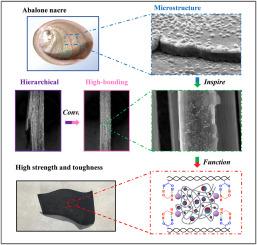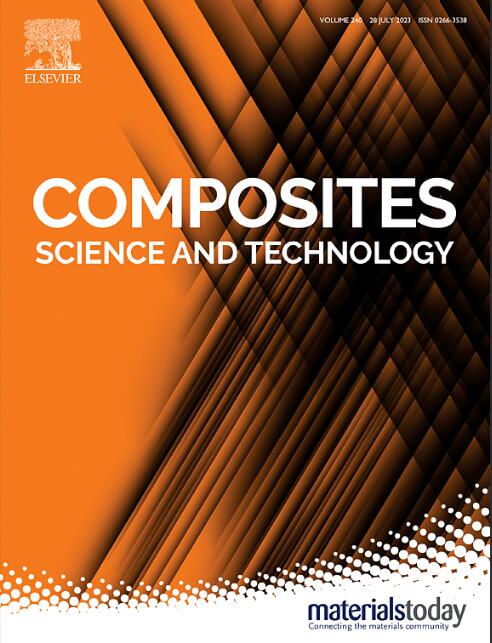生物启发超精细混合纳米涂层用于提高柔性制造中复合材料风扇叶片的强度和耐损伤性
IF 8.3
1区 材料科学
Q1 MATERIALS SCIENCE, COMPOSITES
引用次数: 0
摘要
将受珍珠质启发的超细矿物桥/生物聚合物混合结构应用于复合材料的界面结构设计,旨在解决碳纤维复合材料风扇叶片(CFCFB)的高脆性和低损伤耐受性问题。在此,我们提出了一种简单高效的方法,即 "阳离子共聚物-单胶束介导 "法,将珍珠质启发结构转化为胶束/氧化锌混合纳米涂层的开发。结果表明,这种混合纳米涂层具有超细氧化锌尺寸、单分散性、均匀性和核-壳结构(直径:≈45 nm)等显著特点。此外,该涂层工艺简单、无溶剂,可与可扩展的碳纤维制造工艺无缝集成。基于珍珠光泽启发的界面结构,CFCFB 表现出高层间强度(99.3 兆帕)、高刚度(79 千兆帕)和高韧性(41.2 兆帕 m1/2)。这项研究为复合材料中的生物启发超精细纳米结构设计提供了蓝图,并为其他有前途的工程材料的先进制造策略提供了灵感。本文章由计算机程序翻译,如有差异,请以英文原文为准。

Bioinspired ultra-fine hybrid nanocoating for improving strength and damage tolerance of composite fan blades in flexible manufacturing
The ultrafine mineral bridges/bio-polymer hybrid structure inspired by nacreous is applied to the interface structure design of composite, aiming to address the high brittleness and low damage tolerance problems of carbon fiber composite fan blades (CFCFB). Herein, we present a simple and efficient approach, called the "cationic copolymer-mono micelle-mediated" method, to translate the nacre-inspired structure for developing micelles/ZnO hybrid nanocoating. The hybrid nanocoating was demonstrated to have remarkable characteristics such as ultrafine ZnO sizes, monodispersity, uniformity, and core-shell structure (diameters: ≈45 nm). Additionally, the coating process is simple, solvent-free, and seamlessly integrates with scalable carbon fiber manufacturing. Based on the nacre-inspired interface structure, the CFCFB exhibits high interlaminar strength (99.3 MPa), high stiffness (79 GPa), and high toughness (41.2 MPa m1/2). This study provides a blueprint for bioinspired ultrafine nanostructure design in composites and inspires advanced manufacturing strategies for other promising engineering materials.
求助全文
通过发布文献求助,成功后即可免费获取论文全文。
去求助
来源期刊

Composites Science and Technology
工程技术-材料科学:复合
CiteScore
16.20
自引率
9.90%
发文量
611
审稿时长
33 days
期刊介绍:
Composites Science and Technology publishes refereed original articles on the fundamental and applied science of engineering composites. The focus of this journal is on polymeric matrix composites with reinforcements/fillers ranging from nano- to macro-scale. CSTE encourages manuscripts reporting unique, innovative contributions to the physics, chemistry, materials science and applied mechanics aspects of advanced composites.
Besides traditional fiber reinforced composites, novel composites with significant potential for engineering applications are encouraged.
 求助内容:
求助内容: 应助结果提醒方式:
应助结果提醒方式:


